The economic recovery has taken hold in Minnesota. A low unemployment rate and high labor force participation indicate a relatively strong labor market. This strong labor market hides the fact that some Minnesotans are still struggling to get ahead in today’s economy. Groups that struggled in the past – those who are have less than a high school education, communities of color, recent immigrants, and the young – still face employment barriers today.
The unemployment rate is a measure of those out of work and actively looking for work. When the Great Recession ended in 2009, the unemployment rate in Minnesota was almost 8 percent. Since then, the unemployment rate in Minnesota has decreased, reaching 3.8 percent in March 2017. This is relatively low, compared to the national unemployment rate of 4.5 percent. Despite Minnesota’s comparatively low unemployment rate, upward of 115,000 people are out of work.
In the first quarter of 2017, the groups who struggled the most in the recovery still face more challenges. Unemployment among Minnesotans with less than a high school diploma was six times as high as Minnesotans with a bachelor’s degree or higher. And unemployment among Minnesotans of color was almost 8 percent while white Minnesotans faced an unemployment rate of about 3 percent.
Minnesotans with Less Formal Education Face Hurdles in the Job Market
The gap in unemployment rates between 4-year college graduates and those with a high school degree or less has recently been widening, with Minnesotans with lower levels of education still finding it more difficult to get a job.
- Those with less than a high school diploma are out of work at a significantly higher rate than any other educational group, with an unemployment rate of 12.6 percent as of the first quarter of 2017. While unemployment rates declined after the recession, since 2015 the unemployment rate of those without a high school education has been increasing.
- For those with a high school diploma, the unemployment rate was 5.2 percent, or over twice as high as the unemployment rate for those with a bachelor’s degree.
- The unemployment rate for 4-year college graduates in the first quarter 2017 was 2.1 percent. This group weathered the recession far better than others, and continues to experience very low unemployment.
Unemployment Rate for Young People Hasn’t Improved
Young Minnesotans continue to be more likely than other age groups to be out of work, which can be a significant setback at a critical time for getting started in their careers and may harm their future earnings. While unemployment among young adults ages 16 to 24 has declined since the recession ended in 2009, they still struggle to find employment in the job market.
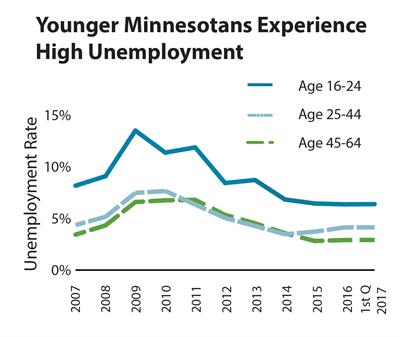
- Workers ages 16 to 24 have had a rough road to recovery. This group has a consistently higher unemployment rate than other age groups with a peak unemployment of 13.5 percent, during the recession. Since 2015, unemployment for this demographic has hovered around 6.4 percent.
- Other age groups of workers saw a less dramatic increase in unemployment during the recession. Workers ages 25 to 44 and workers ages 45 to 64 experienced peak unemployment rates of 7.6 and 6.8 percent, respectively. While the unemployment rate has risen slightly from its low in 2014 of 3.5 percent for 25 to 44-year-olds, both age groups still have unemployment rates below 5 percent.
Single Adults Continue to Struggle Through the Recovery
Households headed by a single adult experience more difficulty in Minnesota’s job market than married couples. Prolonged unemployment can also be harmful to children, with the loss of wages making it difficult for parents to provide nutritious meals and a safe environment, and parental stress causing greater tension in the home. A household headed by a single adult is particularly vulnerable after losing a job, since there isn’t a second income earner to help weather a stretch of
unemployment.
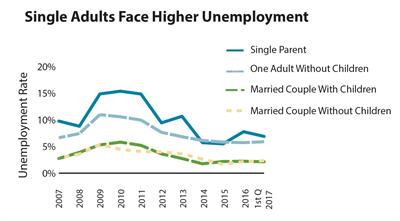
- Single-parent households couldn’t find work following the recession, and unemployment for single parents reached 15.4 percent in 2010. Since then, their unemployment rate has dropped, but as of the first quarter of 2017, 6.9 percent of single parents in the workforce were looking for work.
- Married couples – with children and without children – have seen lower levels of unemployment for the past few years. Since 2015, the unemployment rate for both of these groups has remained consistently around 2 percent.
- Single adults without children have experienced a slow, but fairly steady recovery since unemployment peaked during the recession at 11 percent in 2009 for them. As of the first quarter of 2017, 5.9 percent of single adults without children were out-of-work.
Recent Immigrants to Minnesota have Higher Unemployment
People who have moved to the United States from other countries play an important role in Minnesota’s economy, but they also face hurdles as they strive to participate and make gains in the workforce.
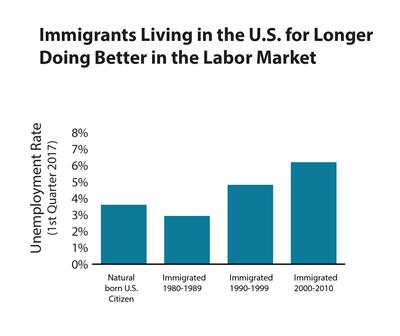
- Minnesotans born in the United States are less likely to be out of work than the most recent immigrants to the state.
- However, this higher unemployment is short-lived. When controlling for length of time immigrants have lived in the country, the unemployment gap decreases significantly. Immigrants who have lived in the United States for longer have increased employment opportunities that starts to mirror the experience of natural born U.S. citizens.
- The unemployment rate of those who have moved to Minnesota from another country most recently is higher than the overall unemployment rate, with an unemployment rate of 6.2 percent compared to the statewide average of 4.5 percent.
Parts of Greater Minnesota have Higher Unemployment Rates
Unemployment varies considerably across the state’s regions, with certain regions of Minnesota experiencing more employment opportunities than others.
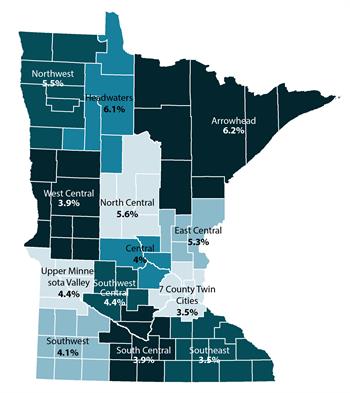
- The Arrowhead region had the highest rate of unemployment in the first quarter of 2017, at 6.2 percent. It was followed closely by the Headwaters region, where the percent of Minnesotans out of work is 6.1 percent. Over 9 percent of workers were unemployed in these areas at the height of the Great Recession, and the unemployment rate is still over 6 percent as of the first quarter of 2017.
- Throughout most of the recession and following recovery, the Twin Cities and the Southeast regions of Minnesota experienced some of the lowest rates of unemployment among the regions. And as of the first quarter of 2017, 3.5 percent of people in the workforce were unemployed in these regions.
Minnesota’s Communities of Color Facing Higher Unemployment
Communities of color have consistently had less employment opportunity than white Minnesotans as they try to get ahead in today’s economy. Unemployment among people of color in Minnesota has improved since the recession, but still remains much higher than for white Minnesotans. This disparity likely reflects many of the other unemployment gaps discussed in this paper, since people of color are more likely to be young or have fewer years of formal education, but people of color also often face more barriers like discrimination in the labor market.
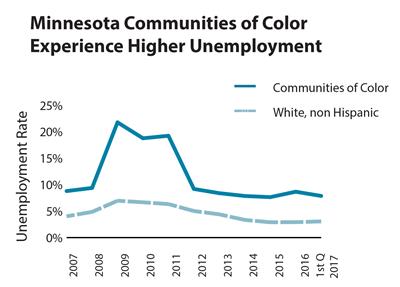
- Employment for communities of color has improved substantially since the recession. However, it is still the case that the unemployment rate for communities of color is 4 percentage points higher than for white Minnesotans.
- Employment for white Minnesotans was less affected by the recession, and white Minnesotans have continued to experience consistently lower unemployment. In the first quarter of 2017, the unemployment rate for white workers was 3.1 percent.
- It is important to acknowledge that different people in different communities of color have varied experiences. Some communities experience much higher barriers to unemployment. For example, the unemployment rate in 2016 was about 13 percent for Native Americans and almost 11 percent for Black or African American Minnesotans.
Policymakers Can Strengthen the State’s Workforce
Despite overall improvement in the unemployment rate, too many Minnesotans still face barriers to gaining a strong and consistent foothold in the workforce. Minnesota lawmakers can support more Minnesota workers to succeed with policies that increase the employment security of those who are currently employed and make it easier for workers to afford the basic expenses needed to get and stay on the job.
For example, one important step to helping workers maintain employment is expanding access to sick leave across Minnesota. In 2012, a study showed that 1.1 million Minnesota workers risked losing wages or even their jobs if they take time off when they or a family member are sick. Expanding sick leave would have a positive impact on the employment of those workers who face the highest levels of unemployment, because they are also those most likely to lack paid sick time, including 60 percent of Hispanic workers and 47 percent of Black workers in Minnesota. Since then, some cities have taken the lead in expanding access to sick leave and it’s time to take it statewide.
Minnesota workers earning lower wages can find it difficult to afford child care, transportation, skills training, and other things they need to succeed in the workplace. For these workers, policies that boost their families’ incomes, such as the Working Family Credit, mean they can better afford those necessities and begin to save so that a temporary setback – such as a car breaking down – doesn’t snowball into bigger problems, including job loss. Similarly, making affordable child care available to more families is crucial to keeping Minnesota’s working parents on the job. Policymakers made some important steps in this direction in the 2017 Legislative Session, such as making the Working Family Credit available to younger workers and expanding the Child and Dependent Care Credit to more Minnesota families. However, there’s still more to do, especially with thousands of Minnesota parents still on waiting lists for child care assistance.
Minnesota has experienced a strong recovery from the last recession, but it’s clear that too many Minnesotans across the state haven’t found the employment they are looking for. Through sound public policies, Minnesota legislators can build the workforce needed to ensure the state’s future economic growth.
By Nathan Williams